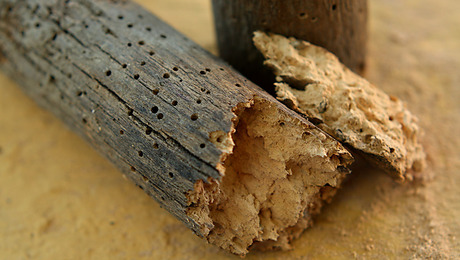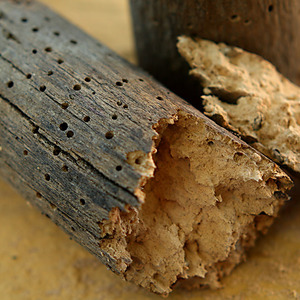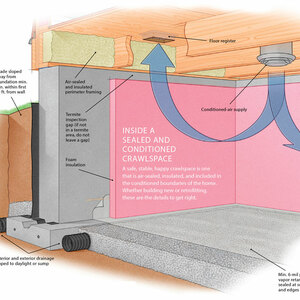Anyone know of a decent book on Craftsman style trim? I’m thinking interior and exterior. I looked over at JLC, and found a book on the subject, but it was more of a history lesson followed by whole house plans, which is not really what I’m looking for. I’m thinking more like a book with pictures along with tips and techniques. Any help or even a reference to a JLC article or FHB article would be nice.
As always, thanks in advance.



















Replies
There's dozens of books available, but I don't know one that specifically focuses on trim.
Personally, I like Paul Duchscherer's books a lot.
I specialize in Craftsman houses; If you have a particular trim in mind I might be able to send you some pics.
Nope, don't have a particular trim in mind, was just looking for ideas and inspiration. I'm going to do a search at Amazon for Paul Duchscherer and see if anything seems to fit the bill. Thanks for the direction though.
Here's an authentic Craftsman trim style that I like:
There is only one book that I know of on trim and that "Shop Drawings for Craftsman Interiors" by Rober Lang.
How it is limited to interiors, it restricted plans from Stickly's magazine, and it have 379 typo's. And that is just on the first page <G>.
But it is still a very good reference to have. And it has lots of details for builtin's.
There are a Ton of books,
One is a reprint of FHB articles. "Fine HomeBuilding Great Houses series" "Craftsman-Styule Houses".
It does not concentrate on trim, but shows a number of examples. Mostly new homes in the A&C styles.
American Bungalow is a quaterly mag that features A&C stuff. Mostly orginal homes, but has also show a number of new houses built in the A&C style. I don't know if they have ever done an article just on trim. But it is a good resource.
And checkout the books in their bookstore.
But go to a big local bookstore and local library and start browsing the A&C books for picture of stuff that you want to "steal".
AB also has a forum. You might ask there if anyone knows of any specific reference books.
Be aware that A&C/Mission/Craftsman/Bungalow/Parie style all have similar roots, but there is also a wide range how the details where executed.
Are you looking to do a modern interpretation or restore a historic property.
Diesel, I just went through this for my house. There's lots of books but it's hard to see the detail in the pictures. I got some ideas from a few model homes that were a more modern arts and crafts style. What I did was made base from 1x6 poplar and eased the top edge with an 1/8" round over bit. For shoe I ripped 1x poplar 1/2" wide with the same round over. I used 3 panel doors and found some great hardware from Emtek. For the door and window casing I used 1x4 poplar with the 1/8" round over on the inner and outer edges. I made plinth blocks from 5/4 poplar with the 1/8" round over on the top and side edges. Above the door was a piece of 3/4" bullnose, on top of that is a piece of 1x6 then capped off with a peice of 5/4. Here is a picture of a houes that I got ideas from. I'll try to get you some of my pics. Hope this helps. -Ed
you really don't expect someone to open that file do you??
REZ!!!!
EricI Love A Hand That Meets My Own,
With A Hold That Causes Some Sensation.
resized image.
There probably isn't a book on trim only. But, Arts & Crafts is in fashion now (again?) and there are dozens of books out on it. Visit a large bookstore and thumb through the books. Arts & Crafts trim is not complex, so you'll be able to memorize a few that you like. Or buy any books that have lots of ideas. You'll probably be interested in other topics once you've decided on a trim.
Here's a photo of one simple trim that could fit the style and is wicked easy. http://forums.taunton.com/tp-breaktime/messages?msg=38882.6
I'm always in favor of looking to the roots...
"Craftsman Homes" - Gustav Stickley
http://www.amazon.com/exec/obidos/tg/detail/-/0486237915/qid=1103693642/sr=1-5/ref=sr_1_5/102-2001121-4892138?v=glance&s=books
I actually have that book. Unfortunately, the bulk of it is floor plans and artists' renditions of the exteriors. There are also numerous pages on furniture, interior decorating, landscaping, and explanations of the Craftsman "philosophy." I enjoy reading up on that stuff, and it helps to fully understand the design concepts of the movement.
However, there are precious few pages of interior renditions, and what little there is lacks detail. As such, it's probably not a good book to use as a source book for interior trim.
However, there are precious few pages of interior renditions, and what little there is lacks detail. As such, it's probably not a good book to use as a source book for interior trim.
I'd agree that if you want detailed diagrams of specific treatments, the book lacks that info, but for $10 you can peruse the publication of the originater of the genre - whadda deal!
"there's enough for everyone"
This is awesome, just the sort of info I was looking for. Thanks to all.
How about posting some more pics? I'm interested in both interior and exterior. Big Pics are fine. Then someone can reduce them for the dial-up users. For example, in the big pic posted above, the details of construction could easily be seen, whereas the small pic was better for giving an idea of the overall look. Matt
To deiselpig and All,
Check out this site:
http://www.A9.com This is a good site if you want pictures or images on a particular subject.
I typed in craftsman style and got lots of images. (if you are looking for style ideas.)
Dan
Looking at examples of Craftsman style (or any other particular style) might be helpful, but I agree with David Doud that to understand something you have to have at least a rudimentry grasp of the underlying principals...like...um...
okay, here's a cahracteristic that helps define Craftsman style - exposed end grain instead of mitered joinery...
there are plenty more we all know...someone else name one...let's do a mind meld and try to get a handle on this thing...
who's next?
A quote from Gustav Stickley, which I believe, helps describe the foundation of craftsman style:
"...to substitute the luxury of taste for the luxury of costliness; to teach that beauty does not imply elaboration or ornament; to employ only those forms and materials which make for simplicity, individuality and dignity of effect."
The use of flat boards, not profile-molded, for all running trim.
Butt the joints where two boards meet on a plane. The only miters you'll see is where trim follows a wall around a corner.
Rectangular or square spindles for staircase balustrades.
Oftentimes a continuous head band is run around rooms. Sometimes throughout the whole house. It usually occurs somewhere up in the 80" off the floor range, and can be a continuation of the head casings.
4/4 jamb casings butting up to a 5/4 head casing or head band trim.
Fireplace inglenooks.
Fireplaces faced with square or bricklaid art tiles.
Square columns, battered. (that means a strong taper from bottom to top)
A fireplace centered in an end wall, flanked by glass-door cabinets both sides, with small window lites above each cab array.
Built-ins, built-ins, and more built-ins.
Pyramid ends for square corbels or lookouts.
Flat-paneled doors.
High-waisted entry doors with a 6-lite window in the top quarter, two panels below.
Through-tenons.
Square pegs through the tenons. Pyramid end the square pegs, standing just proud of the surrounding surface.
If you can afford it, quartersawn white oak everywhere. I once lived in a fraternity house, circa 1905, in which the mainfloor library, 20 x 35 feet, with a huge recessed inglenook fireplace, bookcases all around, was trimmed and paneled in bookmatched QS white oak, with all the bookmatching beginning at the center of the room.
Wood flooring.
A built-in bench near the entry or in the mudroom.
quartersawn white oak everywhere
Not just QS WO, but fumed with ammonia for finish, white oak. Hard to get more "honest" than actually changing the color of the cells in the wood . . . (still trying to imagine how a person would get TNRQC approval for using ammonia on a job site . . . <g>)
One more feature: Tall, very tall, wainscot panels. How tall? As tall as 48" and 60" tall, with a plate rail cap. Which then creates a frieze to the headband. Sometimes the wainscoting carries up to the head band. The panels for that very tall look were sometimes papered or fabric.
Hmm, frieze wallpaper or specialty fabric is another A & C feature, now that I think of it.Occupational hazard of my occupation not being around (sorry Bubba)
Actually while QSWO was Sticklies favorite wood, he did not exclusely use it.In his 'Craftsman Homes" reprint there is a whole chapter on wood and finishes.He also mentions chestnut, brown ash, cypress, and redwood.And Lang's book says that Stickley's home in Syracuse used chesnut trim. And he also planed to use it in his home at Strickley Farms.And on the west coast mahogany and redwood where common.One of the problems with these discussions are that people want to focus on the details and not the "heart" of the design.There are lots of variations between home in different parts of the country, but they are still reconized as "Craftsman".
My interpretation of the "heart" of the Craftsman design philosophy was a return to simplicity. I say "return" because the Victorian designs which immediately preceded them were so heavily ornamented. I once read something from Stickley in which he said the Craftsman designs should honestly reflect their function, and that the only "decoration" should be careful execution of the functional design.
For example, Victorian architecture hid the structural members of the roof: the rafter tails and lookouts were hidden behind soffits. The Craftsman houses have exposed rafter tails. The functional brackets became a design element.
In a similar vein, the mortise and tenon construction in furniture was highlighted. Instead of blind M&T joints, Craftsman designers used through tenons and even locked them with tusks. Again, the functional components of the designs simultaneously became the decorative elements.
---
I guess I should also point out that although Stickley coined the term "Craftsman", the style became much broader than what he individually contributed. So although it's possible to argue that Stickley is the ultimate source and authority for "Craftsman" designs, there are many more valid opinions in the broader style.
Edited 12/22/2004 4:01 pm ET by ragnar
Edited 12/22/2004 4:05 pm ET by ragnar
There are lots of variations between home in different parts of the country, but they are still reconized as "Craftsman".
Truth.
It also occurs that Stickley was also acid fuming some of the wood, too (will have to re-read that section, now, the rememories are piquing my interest).
One of my references refers to challet-style, spanish-revival style, oriental-style, and so on. Can make for some debates, which can get quite heated (is Prairie or Mission a sub-set, or are they styles in their own right, kind of thing)--and I'm trying to keep andy happy by not getting political <g>.
Personally, I like a very minimalist sort of A&C, closer to four-square meets Prairie; trim flat, and wide, but end grains returned and no pegged construction. But, that's me; others differ.Occupational hazard of my occupation not being around (sorry Bubba)
"Personally, I like a very minimalist sort of A&C, closer to four-square meets Prairie; trim flat, and wide"I am sorta Parairie meets G&G.I am going to either do either do one with the head casing a 1/8" thicker than the side casing and over hange it (or the head casing is used to band the whole) room.Or with the all of the casing the same thickness, but with a backband around the outside and maybe a small bead on the inside. I need to do some mockups. For the base probably just clip the top edge by 30 degrees.In the past I have made stuff too flat, but now I am realizing adding some reliefs and layering greating improves the looks.But at the same time I really like some of the radius and cloud lift items in G&G and want to use them in some of the builtins.http://forums.prospero.com/tp-breaktime/messages?msg=51113.40
made stuff too flat, but now I am realizing adding some reliefs and layering
I know that feeling. Running backband as a dado (headrail) really wants a moulded, partial-height, trim to "hold it up," visually. Same deal for head casing--it can want the actual door head different. Like 4/4 on the wall and 5/4 over the door, with a 3/4 - 1" wide back band on top to tie it all together. Cool part there is getting to add some visiual interest by not cutting the door head casing square (think 2-4º). The effect can be quite subtle--but you have to respect the end grain for certain finishes.
I had forgotten about the mantle with the peg details--thank's for posting the reminder.Occupational hazard of my occupation not being around (sorry Bubba)
Well, if I've learned anything about A&C style trim, its that I know nothing about A&C style trim! I think I'm gonna start with the basics and do a little research (the part I was trying to skip) and get a better grasp on what I'm hoping to accomplish here. Then I can start picking out specific details that I want to reproduce. Sound like a decent start?
Thanks to all again for this never ending stream of good information.
brian... greencu linked a Green & Green site... they're a must -see
i have the FHB book "Craftsman Style Houses" very helpful
here's a plan book that is not exclusively A&C...
"500 Small Houses of the Twenties" ... it's hard to say"twenties" and not say A&C
Sarah Susanska's stuff seems to have a lot of A&C influence
Mike Smith Rhode Island : Design / Build / Repair / Restore
For some good ideas, try a pilgrimage to this place: The Robert Treat Paine House in Waltham (not too far off 128). It may be the grandfather of the Craftsman/Arts+Crafts style (I use those terms loosely). Here's the link http://www.stonehurstwaltham.org/home_s.html
pics
Check this site out as well:
http://www.usc.edu/dept/architecture/greeneandgreene/
actually, it just happens that we are doing some work on the house, converting the farmhouse to A&C style - here's a pict of the crew and job...
We've got the same scaffolding as you guys. Same hats too. Small world, eh?
nice pic Dave.
Care to let us in on any more info?
EricI Love A Hand That Meets My Own,
With A Hold That Causes Some Sensation.
wish I knew more, Eric - - this photo was among the thousand or so family picts of the last 150 years that we are sorting and organizing - don't recognize the house, don't recognize the people, haven't seen any other photos among the multitudes that corrospond with it - -
obviously an extensive remodel, building a bungalow over the original 2 room - - has to date to the first 2 decades of the 20th century - the man on the ground is wearing an apron with writing that can't be made out in this scan, with a little computering it could probably be made legible, but it's not on the list yet...right now my main interest is try to ID the generation of the 1860's-80's and get the rest of the photos organized -
"there's enough for everyone"
Hey David, could you show us "moving day" again? Love that shot. You got any old negatives, or just prints?
ya mean this one?
View Image
here's the thread - http://forums.taunton.com/n/mb/message.asp?webtag=tp-breaktime&msg=27256.1&search=y
I did find out that those photos were from the mid 1890's, not 1915 - -
"there's enough for everyone"
Edited 12/23/2004 12:59 am ET by David Doud
ok, vow I remember some of the other photo's.
Neat. You're real lucky to have them.
My grandpa was a carpenter/builder in the early to md 1900's. I have no clue where anything such as you have would exist.
EricI Love A Hand That Meets My Own,
With A Hold That Causes Some Sensation.
are you guys going to use tyvek and foam ins. in that house. the crew looks top notch,whos the small guy ,is he the one that crawls under the overhangs? larryhand me the chainsaw, i need to trim the casing just a hair.
This may not be exactly what you are looking for but try this link. Their moldings are grouped into 4 catagories 1 of which is "Classical Craftsman". There are some pictures, and the moldings are quality made and primed.
http://www.WindsorONE.com
kcoyner